Assume that $y=f(x)$ is an unknown monotonically increasing function of variable $x$. We have access to $N$ observations of this function given as tuples $(x_i,y_i)$, such that $y_i=f(x_i)$. The problem is to estimate $f(.)$ from this observations. In the noise-less case, they obey the monotone condition that $f(x_i) < f(x_j)~,~\forall x_i < x_j$. In the noisy case, some of the observed samples may no longer obey the monotone condition though the majority might be. I am unfamiliar with this kind of problems. Is this specific problem studied in literature? If not, can you point me to the techniques which are used in similar kind of problems?
I did a bit of my own research and Isotonic regression seems like a candidate to me. Is that right?
